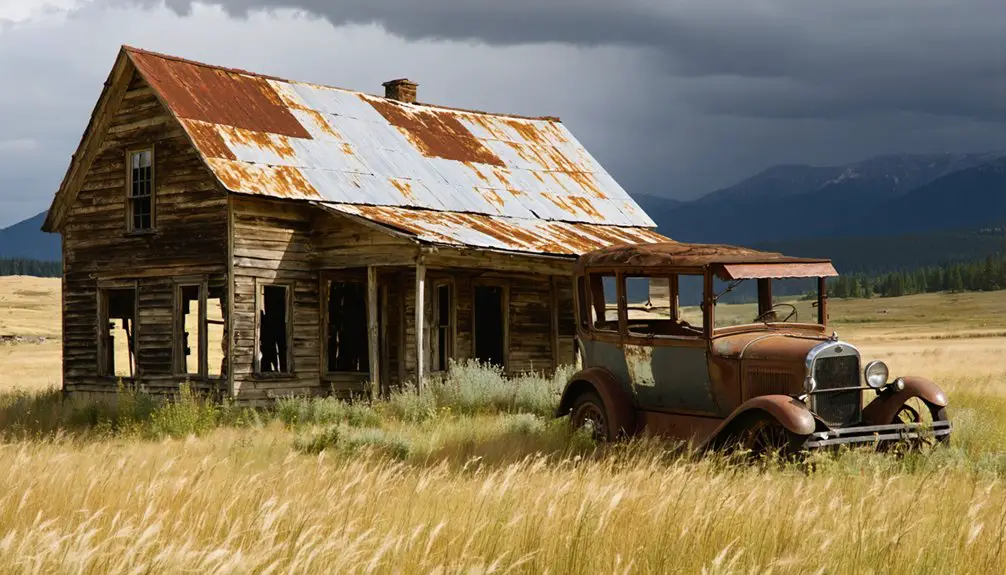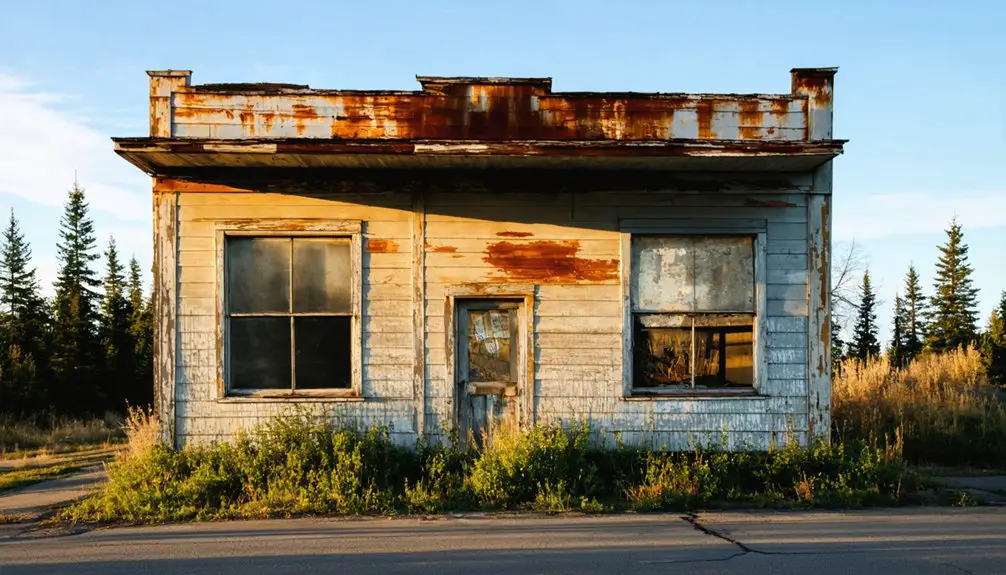You’ll find the remnants of Goshen, a once-promising logging settlement established in 1885, tucked away in the rural landscape of Whatcom County, Washington, five miles northeast of Bellingham. While the town thrived on timber and farming through the early 1900s, its dreams of railroad prominence faded when Tacoma became the Northern Pacific terminus. Today, only the Goshen Cemetery, rural roads, and scattered farmland mark where this frontier community stood. The town’s fascinating story of boom and decline mirrors many forgotten settlements of the Pacific Northwest.
Key Takeaways
- Goshen was established in 1885 near Bellingham, Washington, but became a ghost town after economic decline and post office closure in 1918.
- Failed railroad aspirations and competition from rival towns contributed significantly to Goshen’s eventual abandonment and ghost town status.
- The town’s economy relied heavily on logging and farming, but decreased agricultural yields and resource depletion led to its downfall.
- Few physical structures remain at the original townsite, which has now largely reverted to farmland and rural residential properties.
- The Goshen Nooksack Cemetery, Goshen Road, and Goshen Community Church preserve the legacy of this vanished pioneer settlement.
Origins and Early Settlement
While several pioneer communities emerged in western Washington during the late 19th century, Goshen established its roots in 1885 as a small but ambitious settlement in Whatcom County.
Located just 5 miles northeast of Bellingham and 10 miles south of the Canadian border, this pioneer community quickly took shape around essential farming practices and logging operations.
Strategically positioned near Bellingham and the Canadian border, Goshen flourished through its dual focus on agriculture and timber harvesting.
You’ll find that early settlers strategically chose this location for its proximity to the Nooksack River and abundant timber resources. Much like the mining town of Liberty, which was added to historic places in 1974, Goshen played a vital role in the region’s development. Like the ancient Goshen point artifacts found throughout North America, the town’s name became a distinctive marker of early American settlement.
By 1891, the settlement had grown enough to warrant its own post office, marking a significant milestone in its development.
The community steadily expanded over the next few decades, reaching approximately 100 residents by 1915, as families carved out their living from the region’s fertile soil and dense forests.
Railroad Dreams and Missed Opportunities
Despite Goshen’s strategic location and early promise, the settlement’s aspirations for railroad prominence met a crushing setback when Tacoma was chosen as the western terminus of the Northern Pacific Railroad.
Following the pattern of Seattle’s experience, Goshen residents watched as Northern Pacific’s 60 million acres in land grants helped establish rival towns as regional leaders.
You’ll find that while Goshen maintained a stop on the Bellingham Bay and British Columbia Railroad serving local logging and farming operations, the town’s dreams of becoming a major railroad hub were derailed by fierce economic rivalry and strategic positioning among competing cities.
Similar to the Union Pacific railroad that transformed Wyoming towns in the 1920s, the missed opportunity coincided with devastating economic panics in 1873 and 1893, which further hampered railroad expansion in northern Washington.
Without the backing of a major railroad’s development plan, Goshen couldn’t match the growth of towns like Tacoma and Whatcom that secured stronger rail connections, ultimately contributing to its decline and eventual ghost town status.
Life in a Logging Town
If you’d worked as a Goshen lumberjack, you’d have risen before dawn to tackle dangerous tree-felling and log-bucking operations that could last 12 hours or more.
Your daily routine would’ve included maintaining razor-sharp saws, coordinating with fellow loggers to safely bring down massive trees, and ensuring logs were properly prepared for railroad transport. Workers faced perilous conditions with many accidents caused by dangerous machinery and equipment. The town also operated a large whiskey still that supplied spirits to Bentonville.
The Bellingham Bay and British Columbia Railroad’s regular freight runs were essential to your work, as you’d have relied on its scheduled stops to move timber from the cutting sites to regional lumber mills.
Daily Lumberjack Routines
Before dawn broke over the timber-rich forests of Goshen, lumberjacks emerged from their crowded bunkhouses to begin their grueling daily routines.
After a quick breakfast in the mess hall, you’d find yourself heading into the woods where logging techniques demanded extraordinary physical endurance.
Working in coordinated teams, you’d tackle the day’s challenges:
- Felling massive trees using crosscut saws and axes, coordinating with your fellow fallers for safety
- Limbing and bucking logs to proper length while watching for hazardous conditions
- Maintaining skid trails and guiding horse teams to haul logs to collection points
- Sharpening and repairing your tools during brief breaks to guarantee peak performance
The introduction of steam-powered equipment in the 1880s dramatically changed how loggers accessed and harvested timber in previously unreachable areas.
Your day wouldn’t end until dusk, when you’d return to camp exhausted but ready to do it all again tomorrow. The area’s forty-five shingle mills provided steady work for thousands of loggers across Whatcom County.
Railroad Transport Operations
While timber formed the backbone of Goshen’s economy, the railroad served as its vital circulatory system. You’d find the Bellingham Bay and British Columbia Railroad playing a significant role in the town’s railroad logistics, connecting Goshen to major markets and enabling large-scale timber transport operations. The local railroad was part of the B.B. & B.C. system completed in 1891.
The railroad’s reach extended about 8 miles into the dense forests, where you’d see specialized locomotives hauling massive loads of hemlock, fir, and cedar. Workers endured ten to twelve hours of grueling shifts daily to keep the logging operations running smoothly. You’d witness an intricate dance of coordination between logging crews, rail operators, and mill workers as they moved both timber and important supplies.
When Goshen lost the western depot competition to Tacoma, you’d have noticed the town’s growth potential diminish. The eventual scrapping of rail lines sealed Goshen’s fate, marking its shift toward becoming a ghost town.
The Path to Abandonment
When you examine Goshen’s decline after 1918, you’ll find the closure of its post office marked a turning point in the town’s fortunes.
You can trace how the community’s ambitious dreams of becoming a major railroad hub were dashed when Tacoma won the coveted position as the western depot.
The loss of potential railroad investment, combined with the town’s continued reliance on vulnerable logging and farming industries, set Goshen firmly on its path to abandonment.
Economic Decline After 1918
The economic importance of Goshen, Washington began unraveling in 1918 as multiple factors converged to accelerate the town’s decline.
You’ll find the town’s economic isolation intensified when the post office closed, severing crucial business connections and communication lifelines that had sustained the community since 1891.
Resource depletion and market shifts dealt devastating blows:
- Agricultural yields plummeted while intensive logging exhausted local timber
- Post-WWI economic downturn reduced demand for lumber and farm products
- Transport patterns shifted away, limiting access to broader markets
- Larger urban centers drew commerce and industry from rural areas
Railroad Dreams Fade Away
Despite early aspirations to become a major railroad hub, Goshen’s dreams of rail prominence crumbled as regional transportation networks favored larger coastal cities in the late 1800s.
You can trace the community’s decline to the fateful decision by railroad companies to establish their terminus in Tacoma rather than investing in Goshen’s infrastructure.
While the Bellingham Bay and British Columbia Railroad did serve the town, it primarily focused on resource extraction, limiting Goshen’s broader economic potential.
The railroad expansion that transformed the Pacific Northwest largely bypassed your small community, as companies prioritized more profitable routes through Seattle and other established ports.
Without integration into major transcontinental lines, Goshen couldn’t sustain the growth needed to compete with its better-connected neighbors, ultimately contributing to its abandonment.
What Remains Today

Modern visitors searching for remnants of Goshen will find little evidence of this once-bustling settlement, as no historic buildings or significant ruins remain standing at the original townsite.
The area has largely reverted to farmland and rural residential properties, with only the Goshen Nooksack Cemetery serving as a tangible link to this ghost town‘s past.
Time and nature have reclaimed Goshen’s remains, leaving only gravestones to whisper stories of this vanished pioneer community.
Today, you’ll find these remaining traces of Goshen’s existence:
- Goshen Road and Everson-Goshen Road, which trace routes near the original settlement
- The historic Goshen Nooksack Cemetery (also known as Sulkanon Cemetery)
- Goshen Community Church, maintaining cultural connections to the past
- Former railroad corridors visible as linear clearings, though lacking preservation efforts
The absence of physical structures underscores how quickly pioneer settlements can fade from the landscape without dedicated preservation initiatives.
Legacy in Modern Whatcom County
While Goshen’s physical structures have vanished, its historical influence continues to shape Whatcom County’s identity through preserved place names, transportation corridors, and cultural touchstones.
You’ll find Goshen heritage woven into modern infrastructure, most significantly through Goshen Road and Everson-Goshen Road, which serve as essential transportation arteries in the region.
The historic Goshen Community Church and Goshen Nooksack Cemetery stand as tangible links to the pioneer era, while contemporary housing developments proudly incorporate the Goshen name.
Though the town didn’t achieve its railroad hub aspirations, its legacy lives on in regional literature and local folklore.
The settlement’s story exemplifies the broader narrative of frontier communities and their economic evolution, remaining an integral part of Whatcom County’s cultural fabric.
Frequently Asked Questions
Were Any Notable Crimes or Mysterious Incidents Reported in Goshen’s History?
You won’t find documented unsolved mysteries or crime history specific to Goshen in archival records, though nearby ghost town Govan saw brutal murders including the infamous 1902 Lewis axe killings.
What Was the Average Land Price During Goshen’s Peak Settlement Years?
You’ll find land valuation during peak years ranged from $1-$10 per acre, with economic trends suggesting prices stayed on the lower end since Goshen lacked major rail connections and industrial development.
Did Any Famous Personalities or Historical Figures Visit Goshen?
Ever wonder about notable visitors to this pioneer outpost? You won’t find any famous visitors or historical connections here – there’s no documented evidence of prominent figures stopping in this small railway and logging settlement.
What Natural Disasters Affected the Goshen Community Between 1885-1942?
You won’t find documented earthquake damage or flood impact in Goshen’s records during this period. Despite the town’s location near the Nooksack River, no natural disasters were confirmed between 1885-1942.
Were There Any Indigenous Settlements or Cultural Sites Before Goshen’s Establishment?
Yes, you’ll find the Nooksack and Lummi indigenous tribes had significant settlements near modern Goshen, with cultural sites along the Nooksack River and lowlands before American settlers arrived in the 1840s.
References
- https://www.youtube.com/watch?v=ZdEcAblBVVA
- http://pnwphotoblog.com/ghost-town-of-goshen-washington/
- https://www.whatcomtalk.com/2020/06/05/the-ghost-towns-of-whatcom-forgotten-but-not-gone/
- https://en.wikipedia.org/wiki/Goshen
- https://en.wikipedia.org/wiki/List_of_ghost_towns_in_Washington
- https://octa-trails.org/wp-content/uploads/2023/08/Berge-1990-Lower-Goshen-Archaeology-of-a-Mormon-Pioneer-Town.pdf
- https://stateofwatourism.com/ghost-towns-of-washington-state/
- https://kids.kiddle.co/Goshen
- https://www.wyohistory.org/encyclopedia/goshen-county-wyoming
- https://www.historylink.org/file/1683



